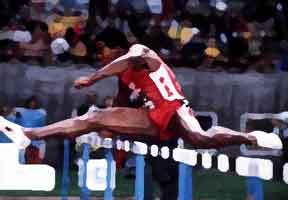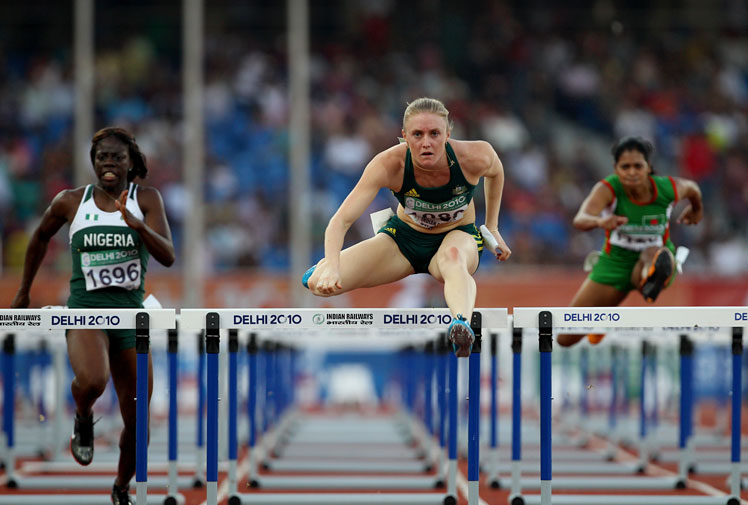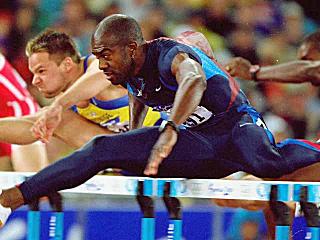



Okay the previous article I wrote, “World Championships Review,” was the soft one. This will be the harsh one. I’m upset, and I’ve been upset for quite a while now, with the American approach to hurdling. Power power power, speed speed speed, technique be damned. It doesn’t work. I’ve put it in kinder terms before, allowing for the fact that there is no one-size-fits-all style, but after the World Championships, I’m getting a bit disgusted with seeing superior athletes from the United States losing to superior technicians from other countries.
What it comes down to is this: American hurdlers don’t know how to hurdle. They’re fast, they’re powerful, they’re strong. But when it comes to negotiating these barriers efficiently, in such a way that allows them to maximize their speed, they don’t know how to do it. Instead of addressing technical flaws, they try their best to cover up their technical flaws. They either just bulldoze the hurdles (male), or run as fast as they can to get past them (women).
And it’s not their fault. It’s the fault of their coaches. Too many American coaches are sprint coaches who have no expertise in the hurdles, no enthusiasm for the hurdles, so they either don’t know how to coach hurdling technique, don’t care about how to coach hurdling technique, or teach a style that is so outdated that it cannot prove successful any longer at the top levels. A lot of coaches are just plain lazy when it comes to the hurdles. All that technical stuff confuses them and frustrates them, so they convert potential hurdlers to sprinters, or they just tell their hurdlers to be “fast and aggressive” and train them accordingly, working through flaws instead of identifying them and correcting them.
It’s an epidemic of arrogance and ignorance, and it’s evident across the board, from the bottom to the top levels. The athletes can only do what they’re coached to do. They can only hurdle how they’re being coached to hurdle. Too many coaches – at the youth level all the way up to the professional level - allow their athletes to go out there and compete with sloppy technique, or, at best, with obvious technical flaws. And if the athletes are fast and aggressive enough, they can win races that way for a while. But eventually it catches up with them, and their lack of attention to details gets exposed.
That’s what we saw this past weekend in the men’s 110m hurdles and the women’s 100m hurdles. When you’re up against a superior technician, and you don’t get a good start, you’re done. You can’t beat a superior technician running from behind. You press, you make mistakes, and your technical flaws prevent you from making up ground gradually, between the hurdles and over the hurdles. You press not because you’re not mentally tough, but because you know you’re in a desperate situation.
Why was Dayron Robles able to walk down Terrence Trammell at indoor Worlds last year? Because he knew his technique would allow him to. He didn’t press. Why was Liu Xiang able to walk down Robles this past weekend after Robles had a phenomenal start? Because he knew his technique would allow him to. Why did Oliver press and slam hurdle two in that same race? Because he knew his technique wouldn’t allow him to catch Robles. Hurdlers with weaker technique can’t race from behind. They have to get a good start. And even if they do, they always have to worry about the superior technicians coming back on them. That was true back in the days when Renaldo Nehemiah was dueling it out against Greg Foster, and it’s true now.
Look at the women’s race from last weekend. Why did Kellie Wells smash into hurdle six? Because she was running from behind, trying to catch up. And when she tried to run faster, her technical flaws got in her way, they prevented her from being able to sprint the way she needed to. Danielle Carruthers and Dawn Harper fared better, but let’s be real here. They had no shot of catching Pearson in that final. She dominated that race from start to finish. It was like watching a varsity kid run against jv kids. And think about it, would you argue that Pearson is faster than the three Americans? Do you think she would beat them in a 100 meter dash? My guess is no. So why is she defeating them by such a huge margin in the hurdles? Because she’s a better hurdler than they are. Straight up. And if they want to beat her, they have to figure out what she’s doing that they’re not. Just trying to get faster won’t work. Just trying to get stronger won’t work. They have to figure out how to hurdle more efficiently, or else forget about it.
So what are these technical flaws I’m talking about? Let me break it down for you. Let me explain to you what Liu, Robles, and Pearson do that the Americans don’t do. Let me start by explaining what they don’t do. Unlike the Americans, they don’t kick out their lead leg. Kicking out the lead leg is a killer flaw. When you kick out that leg and lock that knee, you’re creating an extra motion that you have to execute. Once you lock it, you have to unlock it in order to run again. Also, kicking out the lead leg takes away space – space that could be used to sprint. Instead, the kicking action creates the need to shorten that last stride too much so that you have room to kick. What could be more inefficient than that? Yet American hurdlers at all levels do it.
Finally, locking the knee creates the need to “snap down” the lead leg. And let me tell you something folks, the days of lead leg snap down are dead. Look at Pearson’s lead leg. Look at Robles’ and Liu’s. Their lead legs cycle. They run over the hurdle. They don’t run to it, hurdle it, then run again. There’s no break in the action. It’s a continuous fluid motion. So if Americans want to compete with such hurdlers, we have to take the idea of kicking the lead leg and snapping it down and throw it in the trash can. It was innovative in the 1970s, but it’s not anymore.
What else? Okay, trail leg. You won’t see the trail leg of a Pearson or Robles or Liu lagging behind after take-off, with the knee below the bar. No. That’s American style. Instead, you’ll see the trail leg of these athletes rising high and moving forward as soon as it leaves the ground. Listen to me people. The days of letting the trail leg lag and then whipping to the front are dead. D-E-A-D dead. When the trail leg lags, and then you begin whipping it to the front, it’ll never catch up to the lead leg. It cannot catch up to the lead leg. Why? Because it’s coming from too far behind. So even a fast, powerful, well-executed trail leg will still have trouble making it all the way to the front for ten hurdles. Eventually, you’re gonna start running sideways.
Also, the lag/whip style makes for a low trail leg. So, when you do move it to the front, you have to raise it above the bar while moving it forward. Inefficient! And it also explains why so many hurdlers hit hurdles with the knee and/or ankle of their trail leg. On the other hand, look at Liu. Look at how high his trail leg gets, instantly. It rises with the lead leg, not after it. Same with Pearson. Why do you think these athletes don’t hit hurdles? Why do you think they’re able to shift into another gear in the second half of the race? If it’s not obvious to you, then you’re simply not looking at what’s right in front of your face.
And yes, I do have issues with all the weird things American hurdlers do with their arms. So many women use that karate chop move as the lead arm slices across the body, and so many men do this real high wasted-effort thing with the lead arm that makes no sense to me. I’ve preached about this before. Look at the lead arms of Pearson and Liu in particular. Watch one of their races on YouTube, and just watch the lead arm for the whole race. It’s an amazing site to see. The lead arm is the speed arm. All other limbs will move as fast as the lead arm. So if you’re doing funky things with your lead arm, you’re slowing down the entire motion over the hurdle. The lead arm should stay as close to the action it maintains while sprinting. Yes, you have to open up the elbow to give the trail leg room. But, generally speaking, the lead arm should move in an up/down motion. You get the force you need, and you get back on the ground sooner. All this swinging and whatnot – I don’t get it. I really don’t.
On the women’s side, Americans seem to have come to an agreement that they should minimize their lean in order to stay in sprinting posture. The hurdles are low, so why lean? I’ll tell you why. Because a deep lean from the waist creates forward momentum. Look at Pearson’s lean. She leans forward, toward the next hurdle, toward the finish line. Hurdling upright creates the need to swing the arms, and swinging the arms causes the legs to swing. And the more you’re swinging, the less your sprinting. So, being fast doesn’t matter because all that swinging prevents you from optimizing your speed anyway.

Note Pearson's forward lean, the high trail leg, the tight arms. Though she seems to be high over the hurdle, she's not. Her lead leg is skimming the bar at a downward angle.
The one American hurdler of recent memory who was truly technically efficient was Allen Johnson, and his presence on the scene through the 1990s and most of the 2000’s masked the urgency of the situation. Johnson was a bulldozer early in his career and did win an Olympic gold medal and a World Championship hitting a lot of hurdles. But he figured out somewhere along the way that he couldn’t expect to maximize his potential that way. And that’s what made Allen special – he wasn’t just concerned with winning races; he was concerned with maximizing his potential. Too many Americans, and American coaches, say “Hey, we’re winning, so what’s the problem?” Allen, even when he was winning, saw that he had technical problems that he needed to address. When Allen went up against the world’s best – whether it was Anier Garcia, a young Liu, or anyone else, you always knew Allen had a legitimate chance to emerge victorious because he was a technical master. He didn’t waste effort with a lot of extra motions. His trail leg didn’t lag. His lead leg didn’t kick. These are basic things, y’all, basic things that Americans still haven’t figured out.

Allen Johnson - a true master of hurdling technique.
And I don’t want to hear the argument that Allen was a technician, that not all hurdlers could do what Allen did. I don’t want to hear the argument that some hurdlers are speed hurdlers, some are power hurdlers, some are technical hurdlers. No. You’ve gotta have all three. Speed, power, and technique. Americans, for too long, have neglected technique, and put all their emphasis on speed and power. They’ve come to rely too heavily on their athleticism.
The same malady ails the 400m hurdles. American 400 hurdlers are quarter-milers first, hurdlers second. Stride pattern, rhythm, and technique are an after-thought. Hence the inconsistency. That’s why we have a major championship with a winning time of 48.26. It’s an embarrassment to the event. Edwin Moses was a hurdler. He committed himself emotionally as well as physically to the hurdles. That event was his science, his art. He wasn’t just a great athlete. He was an intelligent athlete. He was a cerebral athlete. He didn’t just eat, drink, and sleep his event. He thought his event. Most American hurdlers don’t know how to think the event. For the most part, they run races on heart and guts and adrenaline, but when it comes to technical execution they just hope something won’t go wrong.

More than just a good quarter-miler, Moses knew how to hurdle.
For me, Lashinda Demus’ victory last week was a triumph of the mind. She lost to Melaine Walker in 2009 due to stride pattern issues, and she addressed those issues so that by 2011 she had corrected them. That 52.47 doesn’t happen if her steps are off. It doesn’t happen if she doesn’t use her analytical mind to figure out what went wrong in ’09. One misstep and Walker would’ve beaten her again.
For some reason, a lot of American coaches think that technique is a secondary skill in the 400 hurdles. Ridiculous. Because fatigue is such a factor in this event, technical efficiency is hugely important. If you have to expend a lot of energy getting over the hurdles, you can’t use that energy to run the race. If your stride pattern is hit-or-miss, you’re going to stutter at some point in the race, and again, you don’t have the energy you need to finish the race strongly. Really, 400 hurdlers should work on their technique just as much as 110/100 hurdlers. They should do work over 39-inch hurdles (men) or 33-inch hurdles (women) in order to force themselves to become more technically sound. Just training like quarter-milers and then putting up the hurdles on race day doesn’t work. Getting back to Edwin Moses, he was a good hurdler. His technique was better than any of today’s 400 hurdlers, without a doubt. Without that efficient technique, there’s no way he could have 13-stepped so consistently throughout his career.
Simply put, America needs to get out of the stone age when it comes to the hurdles. The sooner the better.
© 2011 Steve McGill